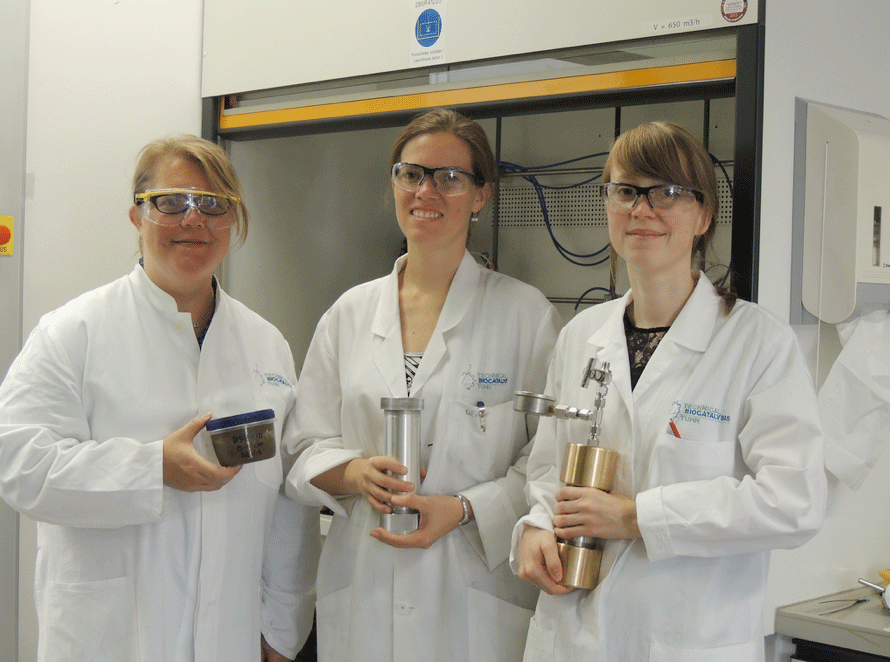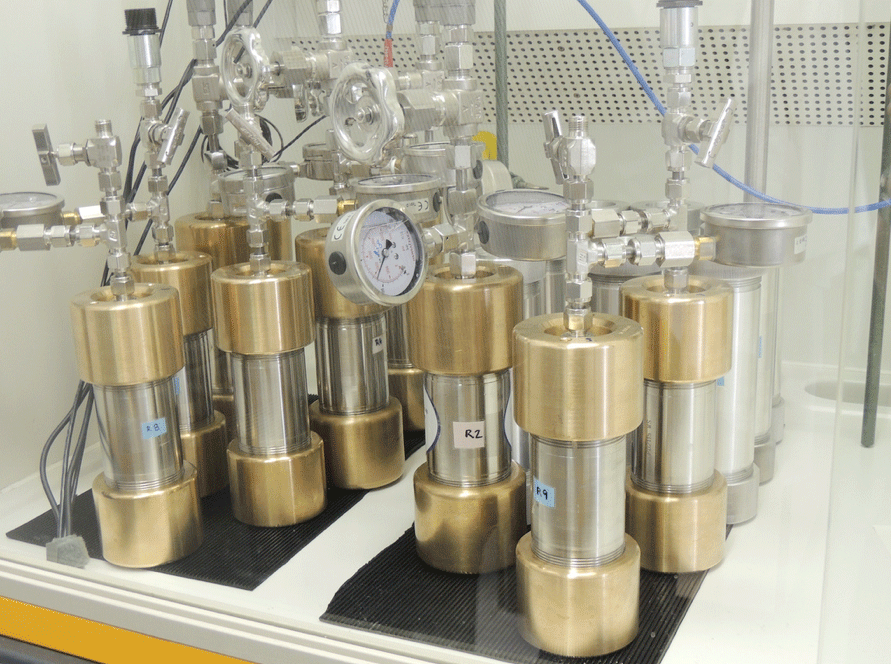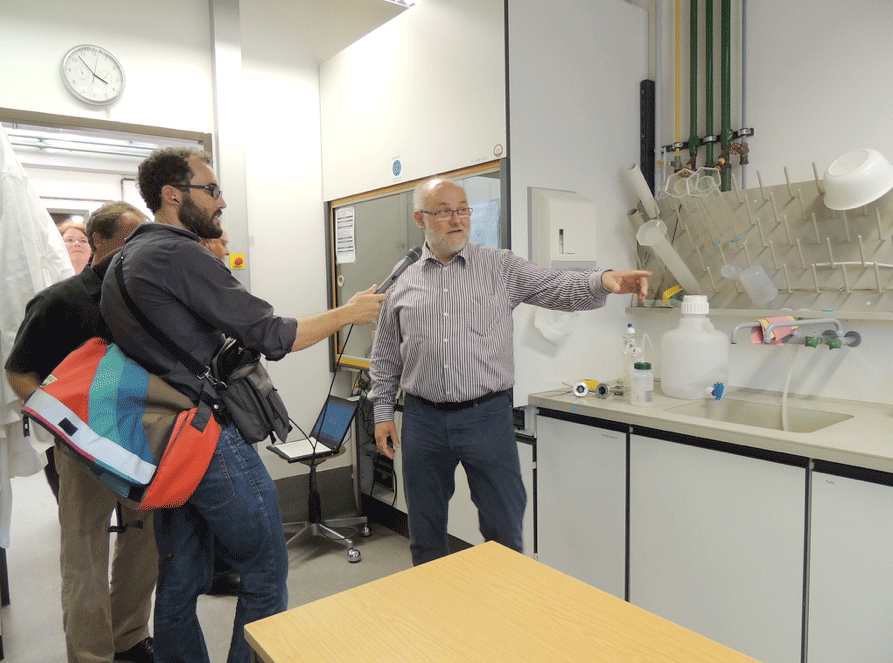Microbes, Dispersants, and Oil in the Gulf
Air Date: Week of March 28, 2014

C-IMAGE post docs Sara Lincoln, Ana-Gabriela Valladares Juarez, and graduate student Martina Schedler hold sediment samples from the Gulf of Mexico and high-pressure chambers in the laboratory at the Technical University of Hamburg. (S. Gilbert)
Four years after the Deepwater Horizon oil disaster, scientists are still studying the effect of dispersants on bacteria that help eat up hydrocarbons. David Levin reports.
Transcript
CURWOOD: When the Deepwater Horizon disaster happened in April 2010, oil gushed into the ocean for nearly three months, and millions of gallons of dispersants were sprayed on the well head.
Some say the dispersants may have made the surface of the ocean look better but at the cost of increasing the toxicity of the spill. Scientific research on the effects of the dispersants is ongoing, and David Levin travelled to Hamburg Germany to check in on the work of scientists from the Center for Integrated Modeling and Analysis of the Gulf Ecosystem.
[FISH MARKET IN ALTONA]
LEVIN: It’s 7 a.m. in Hamburg, Germany, and the Altona fish market is packed with shoppers. Every Sunday, people crowd into the famous open air market, which stretches along the Elbe river. Shoppers haggle over mackerel, squid, shrimp, giant fillets of tuna.
Across town, in a lab full of humming equipment, a team of scientists is looking at their own catch of the day. But they’re not interested in fish. They’re focused on tinier things. Single-celled organisms like bacteria and small plants called algae.
In 2010, the Deepwater Horizon oil spill affected countless little organisms like these in the Gulf of Mexico. And cleanup efforts may have made things even worse for them—to get rid of the oil, crews sprayed huge amounts of toxic chemicals called dispersants into the water. And they had nasty side effects.
Tinka Murk is a researcher at Wageningen University in the Netherlands.
MURK: The unexpected problem we saw now is that it irritated the algae, and the algae produced a kind of protein that is sticky like a spider’s web.
LEVIN: It looked kind of like snot. It stuck to the oil, mixed with sediments in the water, and sank to the bottom.
MURK: So instead of diluting the oil, you are concentrating the oil on top of the sea floor.
LEVIN: That may not seem like a big deal. After all, oil that sinks to the bottom can’t get onto beaches and wetlands. But as it piles up on the ocean floor, it can kill off tiny creatures at the bottom of the food chain. And that has a big impact on other species, like commercial fish.
HOLLANDER: It’s a no-win situation. You have your choice of what part of the ecosystem do you want to impact the most.
LEVIN: David Hollander is a geochemist from the University of South Florida. He’s here in Hamburg to meet with researchers who study the spill.

High-pressure reactors are constructed to monitor biodegradation under deep-sea conditions at pressures up to 150 bars. (S. Gilbert)
HOLLANDER: The technology for cleanup has lagged behind the technology for exploration significantly. Once the Deepwater Horizon spill happened, they were using large amounts of dispersants—essentially the identical technologies that were used in the 1970s, they were using in 2010 to clean up the oil.
LEVIN: So… how do you deal with that much oil? Well, it turns out, some tiny creatures in the Gulf already have a solution. They eat it.
MÜLLER: There are bacteria in our environment, and you find them everywhere, that can eat oil as food. And the more food they get, the better they grow.
LEVIN: This is Rudi Müller, a microbiologist at the Hamburg University of Technology. He says that after the Deepwater Horizon, species of bacteria that live on the sea floor had an all-you-can eat buffet. But exactly how much they ate, or how fast, is still kind of a mystery.
MÜLLER: There are indications that the bacteria grow down there on the oil. But the question there is, how do bacteria behave in the deep sea, under high-pressure, low temperature conditions?
LEVIN: To figure that out, Müller’s turning to custom-made equipment.
[WHIRRING FANS, LAB SOUND]
MÜLLER: So, here’s the pressure lab…
LEVIN: Under a plexiglass lab hood, Müller points to a half-dozen bronze cylinders. They don’t look like much—each one’s only about a foot tall. But inside them, he’ll mix bacteria and oil, then crank the pressure up to more than two thousands pounds per square inch to recreate conditions at the bottom of the Gulf. By studying what happens next, he can learn what the microbes actually do to oil in the deep ocean.

Professor Dr. Rudolf Müller, a microbiologist at the Hamburg University of Technology, talks to David Levin about organisms that live deep in the ocean and eat oil. (S. Gilbert)
Working with devices like these isn’t always easy, though.
[CLANKING SOUNDS]
Ana Gabriela Valladares Juárez is fighting with a mess of pipes and valves she’ll use to pressurize the cylinders. She’s a post-doc in Müller’s lab. In one hand, she holds a pair of pliers—in the other, a big wrench.
JUAREZ: So now, we can open the valve.
[HISSING SOUND FROM VALVES]
Oh! As you see, we have a leak…
LEVIN: Leaks like these aren’t uncommon. Valladares Juárez says it can take hours to get a solid connection. But once the experiments are up and running, she’ll be able to see how bacteria break down the oil, and what conditions make it possible.
[CLANKING SOUNDS]
This is not just an academic exercise. David Hollander says studying these bacteria might lead to a new way of cleaning up oil spills.
HOLLANDER: There’s new visions for different types of dispersants which not only involve the breakdown of oil into finer particles, but the application of microorganisms that are capable of degrading the oil, so that when the dispersants break it into small particles, the microorganisms can attack it.
LEVIN: In other words, it might be possible to harness bacteria that already love to eat oil, and use them to our advantage during a spill.
Again, Rudi Müller.
MÜLLER: There, it might be helpful, yes. As a starter to have a faster degradation in the first, say, few hours or the first day or so.
LEVIN: The idea is if you can put the right bacteria in the right place at the right time, you could break down the oil enough to get rid of its most poisonous ingredients – compounds like benzene and toluene.
MÜLLER: So there are a lot of compounds that you can degrade when you have the right bacteria. The question is can you do it reliably? Does it make sense? How much does it cost to do it?
LEVIN: To make this possible, Müller says you’d need a huge supply of oil-eating bacteria ready to go at all times, and you’d have to pump them onto the oil within a few hours of a spill. Scientists are still a long way from making that a reality. But if they did, it could make a big difference for first responders, who get exposed to those toxins during cleanup.
For now, though, Müller and his team are focused on learning as much as they can about the bacteria themselves. Like how they behave. How they actually use the oil, and what happens to them in the process. By understanding how these organisms work, the researchers might be able to tell what role the bacteria naturally play in the aftermath of an oil spill. And someday, that might even change the way we react to those disasters.
For Living on Earth, I'm David Levin in Hamburg, Germany.
Living on Earth wants to hear from you!
Living on Earth
62 Calef Highway, Suite 212
Lee, NH 03861
Telephone: 617-287-4121
E-mail: comments@loe.org
Newsletter [Click here]
Donate to Living on Earth!
Living on Earth is an independent media program and relies entirely on contributions from listeners and institutions supporting public service. Please donate now to preserve an independent environmental voice.
NewsletterLiving on Earth offers a weekly delivery of the show's rundown to your mailbox. Sign up for our newsletter today!
 Sailors For The Sea: Be the change you want to sea.
Sailors For The Sea: Be the change you want to sea.
 The Grantham Foundation for the Protection of the Environment: Committed to protecting and improving the health of the global environment.
The Grantham Foundation for the Protection of the Environment: Committed to protecting and improving the health of the global environment.
 Contribute to Living on Earth and receive, as our gift to you, an archival print of one of Mark Seth Lender's extraordinary wildlife photographs. Follow the link to see Mark's current collection of photographs.
Contribute to Living on Earth and receive, as our gift to you, an archival print of one of Mark Seth Lender's extraordinary wildlife photographs. Follow the link to see Mark's current collection of photographs.
 Buy a signed copy of Mark Seth Lender's book Smeagull the Seagull & support Living on Earth
Buy a signed copy of Mark Seth Lender's book Smeagull the Seagull & support Living on Earth

